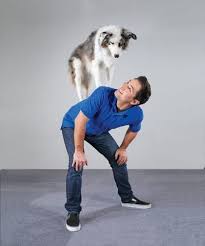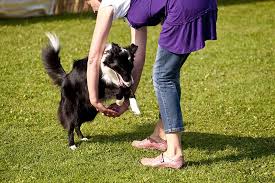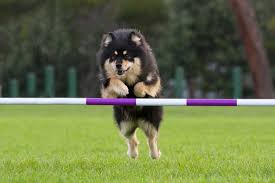Trick training, the skillful art that turns ordinary dogs into theatrical marvels, has made quite the journey from early Hollywood sets to today’s dog parks and training classes. I’m going to take you back to where it all began – the Roaring Twenties. It was then that a German Shepherd named Rin Tin Tin leaped onto the silver screen, capturing hearts and sparking the imagination of dog lovers everywhere. This four-legged star wasn’t just about looks; his impressive repertoire of tricks earned him an esteemed place in cinematic history and kick-started the trick training movement.
Fast forward a couple of decades to the 1940s, when another four-legged icon named Pal, a rough Collie, was about to take the baton. Creating the character ‘Lassie’ for feature films, Pal and his trainer, Rudd Weatherwax, not only won over audiences but also changed the dog training game. Weatherwax introduced innovative techniques centered around positive reinforcement and food rewards, ideas that were rather revolutionary for the time. His methods proved so effective that he penned a trick dog training manual, influencing a generation of dog trainers and enthusiasts.
Such was the impact of these early pioneers that today, trick training features prominently in Canine Good Citizen (CGC) programs. CGC classes, recognized as a standard for well-behaved dogs, now often include elements of trick training, attesting to its effectiveness and appeal. The growing popularity of this engaging activity doesn’t just rest on enjoying a well-performed ‘play dead’ or ‘roll over’. It’s deeply rooted in the historical successes of those who recognized a dog’s potential for greatness, both onscreen and off.
And it wasn’t just the Weatherwaxes of the world pushing the boundaries. In the 1960s, Captain Arthur Haggerty, a name synonymous with modern dog training, made his mark. He trained canines for the movies and co-authored the influential ‘Dog Tricks’ in 1977, further cementing his legacy. His work, just like his predecessors, underscored the notion that anyone with a bit of patience could achieve remarkable results teaching their dogs tricks.
This legacy has flourished over the decades, with notable modern-day contributions like Kyra Sundance’s ‘Do More With Your Dog!’ program. Today’s dog owners have a wealth of resources at their fingertips – a treasure trove of books, videos, and online tutorials – each promising to unlock the potential of man’s best friend through the power of trick training.
But this isn’t just about a stroll through the annals of dog training history. It’s also about understanding why this form of entertainment has endured and expanded. Trick training is more than a display of talent; it’s a source of joyful interaction between dogs and their handlers. With positive reinforcements such as food or enthusiastic praise, each trick learned is a victory shared, a moment of pure connection. That’s the true heart of trick training – the emotional bond it forges between human and canine.
The Joy of Learning Together: Why Trick Training Captivates Dogs and Owners
I’m going to let you in on a little secret: trick training is as delightful for dogs as it is for their human partners. Think about the last time you learned a new skill and got it right; that sense of accomplishment is also what your dog feels when they master a new trick. This section unpacks why the process of learning tricks together can be an incredibly fulfilling experience for both you and your furry friend.
Positive reinforcement and those tasty food rewards can work wonders. When a dog realizes that following directions leads to a delicious treat, or even better, an enthusiastic ‘Good dog!’, their motivation skyrockets. And it’s not just about the snacks or the praise; it’s also about the loving interaction and attention they get from you, which for many dogs, is the best treat of all.
As you teach tricks to your dog, you’re doing much more than just training them to perform on command. You’re enhancing the bond between you, fostering deep trust and understanding. Each new trick learned is a step forward in your relationship, a true testament to teamwork and the time you’ve invested in one pens other.
Interestingly, my observation is that dog owners often revel in the quirky and fun nature of tricks, sometimes even more so than they appreciate the mastery of basic obedience behaviors. There’s something inherently satisfying about seeing your pup play dead on cue or give you a high-five. These fun moments are not only impressive to others but also create joyful memories between you and your canine companion.
More Than Just Tricks: The Educational and Social Advantages
Trick training isn’t just about teaching your dog to play dead or give high fives. It goes much deeper, offering a whole suite of benefits that extend beyond the living room show-off session. Think of it as a school for dogs where each trick adds to their education and growth.
Not just a mere pastime, tricks serve as a practical form of exercise, setting the stage for both physical and mental stimulation. Regular training sessions combat boredom and can even curb those notorious destructive behaviors some dogs exhibit when under-exercised or mentally unstimulated. This leads to a happier, more content pooch who’s less likely to dig up your garden or chew on your favorite shoes.
Shelter dogs often face the sad reality of being overlooked, but a dog who can perform a few tricks often stands head and tails above the rest. Tricks can be a real game-changer, enhancing their chances of capturing the hearts and interest of potential adopters. It showcases their ability to learn and adapt, traits that make for an easier transition into a new home and family life.
Let’s not forget our young animal enthusiasts. Trick training can be particularly beneficial for children and teens interested in dog training. It provides a constructive way for them to engage with their pets, teaching them responsibility while fostering a nurturing relationship with their four-legged friends.
Diving into the realm of trick training opens up a world where principles like shaping, chaining, and positive reinforcement aren’t just academic terms but become real, tangible experiences. New trainers get to develop their skills in a forgiving and fun environment, making learning enjoyable and effective for both human and canine students.
Building a Team: Trick Training as a Pathway to Enhanced Communication and Cooperation
You’ve learned about the rich history of trick training and the sheer delight it brings to both you and your furry friend. But this isn’t just about fun and games; it’s also about forging an unbreakable bond. In this final section, I’m going to show you how trick training is the perfect canvas for you and your dog to create a masterpiece of teamwork.
Trick training goes beyond the simple back-and-forth of command and response; it’s about understanding each other. When you invest the time in teaching your canine tricks, you’re speaking their language, which strengthens your mutual communication. The satisfaction you both gain when a new trick is mastered? That’s the evidence of your teamwork in action.
If you’re excited by the camaraderie that comes from trick training, you’re going to find a wealth of resources to help you. Kyra Sundance’s ‘Do More With Your Dog!’ program stands out as a beacon for dog owners looking to push beyond the basics and truly collaborate with their dogs on a deeper level. It’s a resource I highly recommend exploring.
And remember, consistency is key. Choose something that resonates with you and your dog, and stick with it. Not only will practicing tricks keep your dog’s mind and body active, but it will also keep unwanted behaviors at bay. As you grow together through trick training, you’re not just teaching them how to roll over or play dead; you’re nurturing a highly responsive and attentive companion.
Trick training, in essence, is a celebration of the canine-human connection. It’s a testament to what can be achieved when two minds work towards a common goal. Encourages dog owners to start teaching their dogs tricks now. As your dog’s repertoire of tricks grows, so too will your mutual trust and enjoyment of each other’s company. In the end, the tricks your dog performs are the icing on the cake; the real treat is the journey you’ve shared along the way.
“Brain Training for Dogs” is, in my opinion, an extension of this training. Click on the image on the left , check it out, and give me your thoughts.

P.S. This post contains Affiliate links. If you make a purchase through these links I may earn a small commission, at no extra cost to you”


Hi, hope you are doing well!!
The article “Trick Training For Dogs” is an excellent post that is explaining the nuances of dog training with clarity and enthusiasm. A detailed insight into the history and methods of trick training, combined with practical tips, make the article an invaluable resource for dog owners. The passion and expertise evident in the writing ensure readers will be motivated and well-equipped to enhance their dog’s skills and strengthen their bond.
Keep up the good work, Cheers!!
Nouman
This article is a delightful journey through the rich history and enduring appeal of trick training for dogs! The emphasis on positive reinforcement and the emotional bond between dogs and their handlers is heartwarming. It’s inspiring to see how something as simple as teaching a dog to play dead can become a meaningful exercise in cooperation and mutual understanding.
Overall, this article does a fantastic job of showcasing the multifaceted benefits of trick training. It’s not just about the tricks themselves but the joyful journey and strengthened bond between dogs and their owners. Thanks for sharing such a thoughtful and engaging piece!